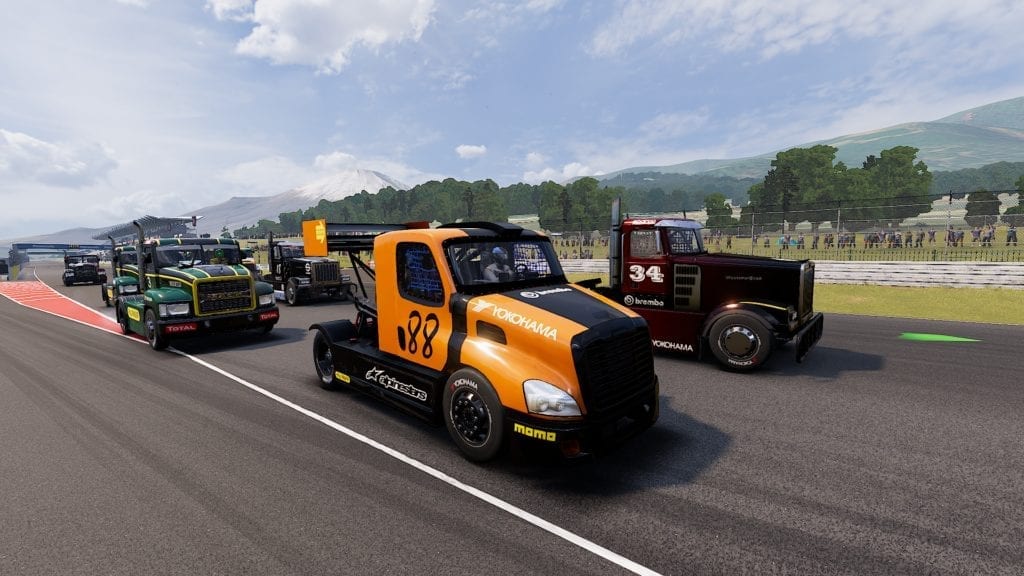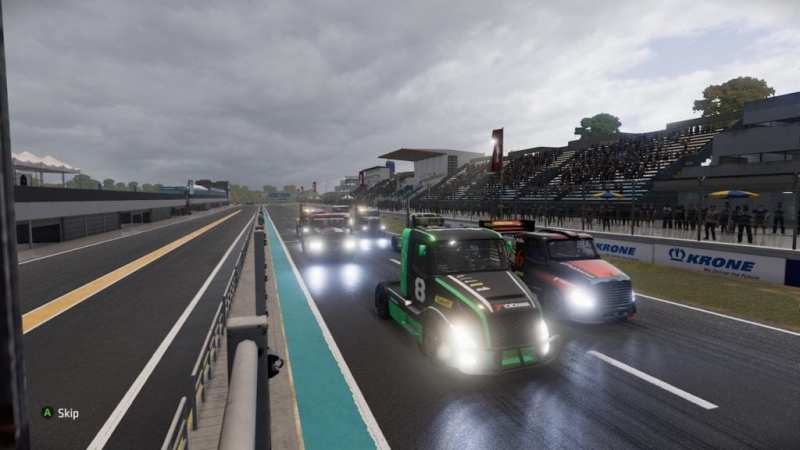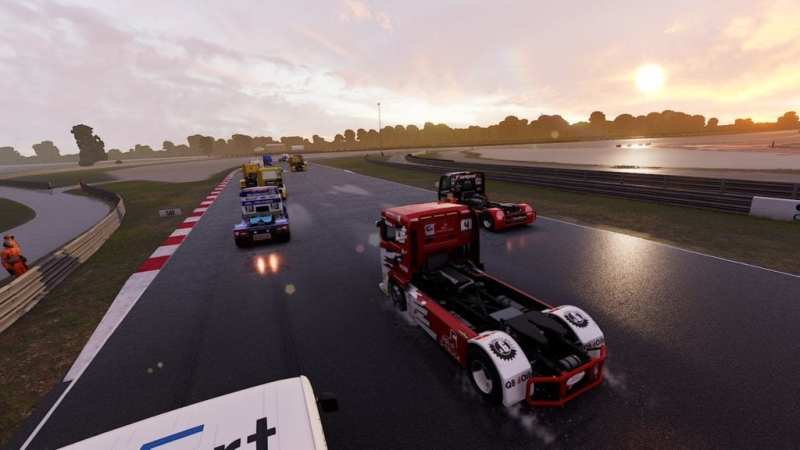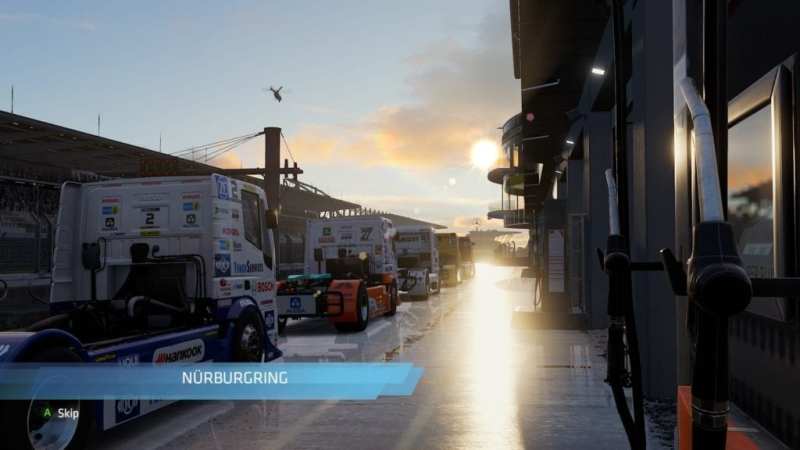From a game mechanics perspective, racing titles are just about the simplest in terms of their design. Since they’ve always been one of my favorite genres, it’s safe to say that I’ve come to know what to expect from the average title. That’s why I was a bit thrown off by FIA European Truck Racing Championship (which I will refer to as Truck Racing Championship/TRC for the rest of the review). For all intents and purposes, one could consider it a ‘sim-cade’ title. However, it’s certainly not like your average car racing game.
Big rigs, big quirks
The biggest difference between TRC and a more traditional track racer lies in the fact that it puts you behind the wheel of trucks rather than cars. Of course, that’s the game’s whole schtick; it’s supposed to be different, in addition to being a bit of a surprise. The marketing material sheepishly implies that some don’t even know that truck racing is an actual thing. After all, you’d usually see these machines meandering down highways as they haul Amazon Prime deliveries and the like in freight trailers. Thus, these trucks are not your average cargo semi.
In TRC, your truck accelerates far more quickly and is more maneuverable than a typical cargo hauler. However, it’s still nowhere near the same experience as taking control of an F1 car, or a Porsche 911 made for track racing. These big boys are still heavy, lumbering monoliths. Thus, if you’re accustomed to a typical racing title, this does take some getting used to. That’s why, before you even reach the meat of the Career mode, you must complete a series of interactive tests which will then grant you a proper license in order to actually race in a truck. I’ve never played a racing game with a mandatory “Driver’s Ed”, but I appreciated it. While the fundamental driving experience isn’t extremely different, there are some quirks nonetheless.
Things don’t feel too different while you’re on the track on your own during practice or qualifying. Once a proper race begins, however, the quirks really start to show themselves. These 5-ton metal blocks weren’t initially intended for racing, so they’re not all that maneuverable. That said, I managed to pull off some serious drifts under the right conditions. At the same time, I found myself spinning out very often when not careful. And the recovery from that is not as simple as in a car, as it does take a while for these beasts to swing around and get back up to speed.
The beginning of every race becomes kind of a battle, as having 12 big rigs mere inches from each other always serves as a recipe for chaos. Thus, the main goal during the first lap is to try and gain some forward positions. As the races progress, eventually things space out. Even so, I spent a lot of extra minutes on some races due to having to restart within the first few moments because of my opponents boxing and bashing me. Escaping a pile-up of cars is one thing, but rigs are a whole other story. Thus, expect to run into many frustrations just from the sheer make-up of the situation. You basically have to keep reminding yourself “these are not cars.”
Career crawl
Truck Racing Championship splits Career mode up into two parts: the European mode and the World Series. These function the same way, with the only differences lying in the truck models and tracks. The European Career features exclusively European trucks from manufacturers like MAN and Iveco. The World Series, on the other hand, invites other truck makes into the mix. These trucks tend to be more nimble and can accelerate more quickly than their European counterparts. Track-wise, as the names suggest, the European Career has you racing on various real-world tracks around Europe. Meanwhile, the World Series includes tracks from a variety of countries like the USA, Australia, and Fiji.
Your first run through the Career mode will basically serve as a trial period, allowing you to hone your skills and improve yourself. Rather than buying your own truck, you drive for sponsors who have their own teams, and that selection is made before the racing season begins. At first, you’ll switch teams following every race weekend (which consists of four main races on a track). After you complete the first season, then you have the option to sign with a team for an entire season. This will then require you to perform maintenance and repair the truck after each race (which costs money), make upgrades to its parts, and keep the team morale up by placing in high positions. This system works similarly to other racing sims like the F1 series, though it’s not nearly as technical.
The real catch with the Career mode is that it does take some time to get through. At maximum length, races last for up to 12 laps. However, you thankfully have the option to shorten them to 75% (8 laps), 50% (6 laps), or 25% (3 laps). Even a 3-lap race can take nearly 10 minutes to complete, primarily due to the trucks’ slow speed (they only get up to 99 MPH). A full race session consists of the aforementioned four main races, plus two practice sessions, two qualifying rounds, and sometimes Super Poles (which are a single lap). So, a full race session has about nine components. It didn’t take me long to adjust the length to only 25%. Even then, a race weekend still took me almost an hour to complete on average. Thus, you can expect to plod your way through at far less than lightning speed.
It’s the long, repetitive nature of the Career mode which made it more annoying than enjoyable for me. After a few hours, I basically lost interest in actively playing. Instead, I started putting on YouTube videos and listening to Spotify playlists while I raced to truly keep my mind occupied. Racing games are supposed to be exciting and engaging! But for me, TRC only managed to provide that feeling in very short bursts.
An acquired taste
Coming to that realization basically led me to conclude that TRC is more of a niche type of racer. Even if you enjoyed titles like Assetto Corsa, Project CARS 2, and Forza Motorsport 7, you may not necessarily jump for something like this due to its differences. In fact, Forza 7 does happen to include truck racing as one of its disciplines; actually, that game introduced me to the sport. Honestly, I prefer it there, as it served as a tiny portion of the experience rather than the whole product. Thus, for me, TRC proved more of a slog than a speedy celebration.
In addition to the meandering gameplay, the presentation also isn’t much to make noise about. Visuals are simplistic compared to other modern titles, though the lighting effects particularly sunset/sunrise were very pretty, especially after a shower. Speaking of weather, I’ve seen it become overcast and the roads turn wet, but I never actually saw any animated rain (though the trucks do have functional wipers). The physics do change under wet conditions, at least.
The sound design is also sub-par. While the engine sounds are pretty nice and bass-heavy (as you’d expect from a big rig), there aren’t any unique sounds for each truck. That, again, adds to the repetitive nature of the game.
All things considered, at $40, it’s hard for me to truly recommend FIA European Truck Racing Championship unless you happen to be a big fan of titles like American Truck Simulator/ European Truck Simulator 2. But, if super-fast racing is more your style, you’re headed down the wrong road in this case.










Published: Jul 28, 2019 12:00 pm